Posted At: Sep 06, 2024 - 27,188 Views
5 minutes to read

The Rise of On-Demand Applications
Whether it be the beauty salon industry, healthcare, education, or restaurant, booking services manually is a cumbersome task for both the customers and their service providers. It’s an unnecessarily manual process involving calls and checking schedules that wastes the time and resources of both sides with a non-streamlined process that is bound to result in human errors. This needlessly time-consuming process is thus no longer preferred by modern tech-savvy people.
Enter the world of innovative on-demand appointment booking applications, making the booking process incredibly streamlined to gain maximum bookings and profits with 24/7 booking convenience, hassle-free booking management, easier payments, reduced workloads, and data-driven insights. As the world goes mobile, leading businesses embrace the mobile booking trend, helping them meet customer expectations and capitalize on lucrative opportunities.
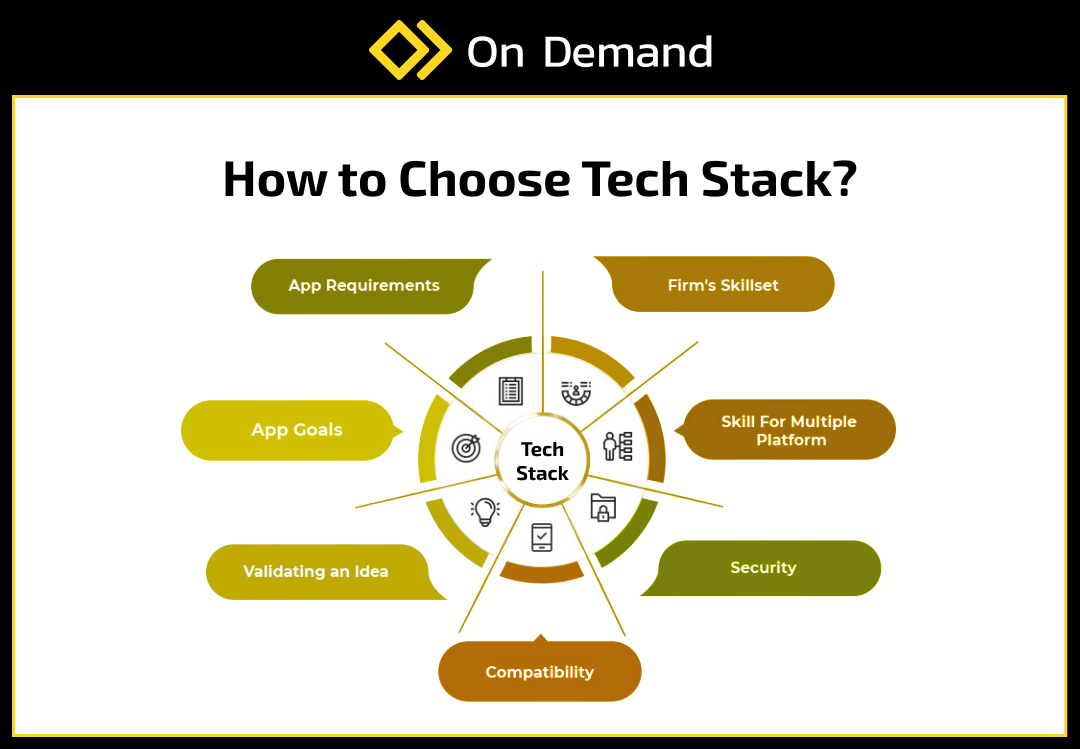
As the projected revenue of the on-demand app landscape is expected to reach $335 billion by 2025, businesses globally are scouting for a reliable partner to help integrate an on-demand appointment booking application with their business services. A dedicated on-demand booking app development team that provides custom solutions built from scratch is thus a valuable commodity that can help you reach the genuine potential of your business with considerably low investment and quicker results than other manual alternatives.
However, before moving ahead, this process requires in-depth technical knowledge to avoid confusion when dealing with on-demand mobile app developers. Understanding the importance of the technology stack for on-demand apps is crucial to ensure better integration and reliability, which is what we have aimed to cover with this blog.
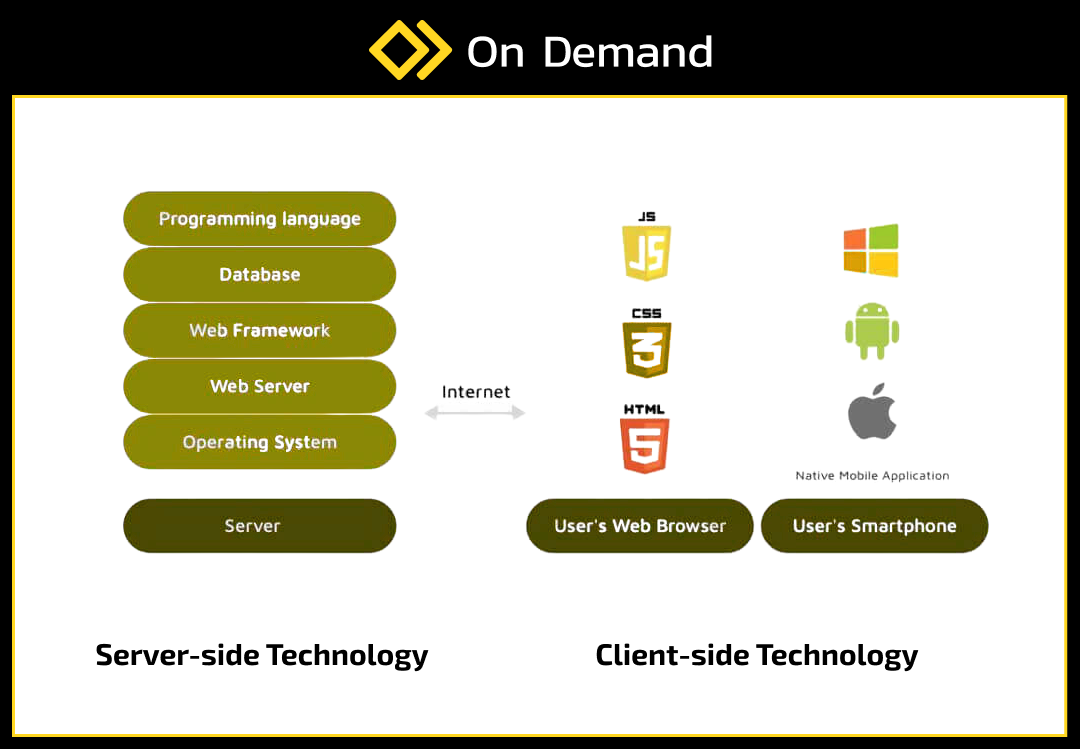
Industries Benefited by On-Demand Appointment Booking Applications
There are a myriad of different global industries that can benefit from on-demand appointment booking functionality for automated bookings. Some of the primary ones include:-
- Beauty salon industry
- Doctor appointment booking app
- Restaurant reservations
- Home care services
- Handyman services
- Car rental services
- On-demand laundry app
- Bus reservations
- Car wash services
- Carpooling services
- Pet care services
- Tutor booking services
- Fitness Industry
Unmatched UI & UX: Front-End Technologies
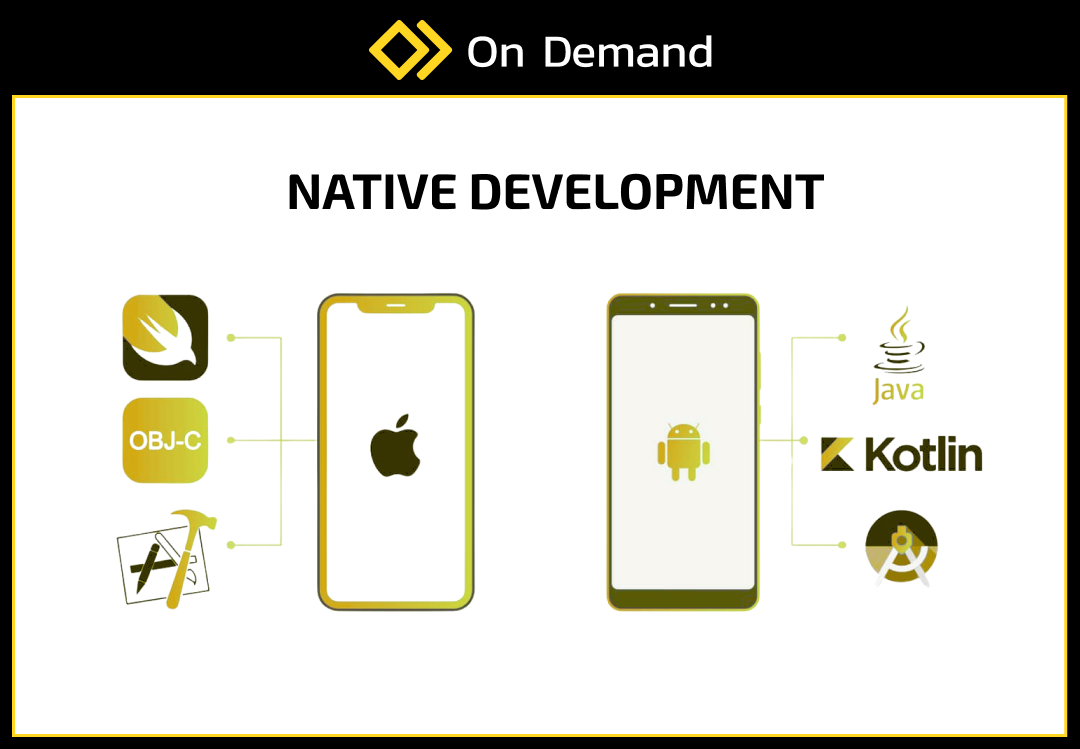
The technology stack for on-demand apps has three different interfaces: customer app, service provider app, and web admin panel. The UI design aims to create a lasting impression on customers, improving conversion and retention. It must be mobile-responsive and perform at speed. Professional on-demand app development companies ensure that graphics should not be large as they negatively impact performance. This is why front-end technologies and a unique UI and UX can ensure that you attract a wider audience that is interested in learning more about your services, with an attractive and intuitive design that appeals to their eyes.
- Front-End Development Tools
Front-end developers translate design into code using HTML5, CSS3, JS, Bootstrap, Angular, jQuery, and SASS. Raise the bar of convenience and usability in appointment booking apps through unmatched UI design engineering that creates a win-win situation for both customers and businesses.
- Framework and Libraries:-
Front-end development for on-demand app development often uses libraries and frameworks such as React.js, Angular and Vue.js to provide a competent architecture and dynamic integration of better design elements and widgets. This ensures that languages like HTML5, CSS3 and Javascript are used to add further interactivity and native-like performance to both webpages and front-end designs of on-demand app development technology stacks to gain the most optimised software experiences for the users.
On-demand App Development Technology Stack Costs
While every company and enterprise hopes for getting the most modern and feature rich on-demand application, it is vital to note that higher complexity equals to higher cost in terms of it’s development. This is because integrating more functionality within the technology stack of on-demand apps requires more platforms and architecture to support the newer widgets and functioning, which adds dramatically to the overall cost of development.
An estimate of on-demand app development technology stack costs according to its complexity is:-
| On-Demand App Complexity Level | Estimated Cost Range (USD) |
| Basic Complexity | $20,000 - $65,000 |
| Average Complexity | $60,000 - $140,000 |
| Advanced Complexity | $75,000 - $200,000 |
The Backbone of Performance: Back-End Technologies
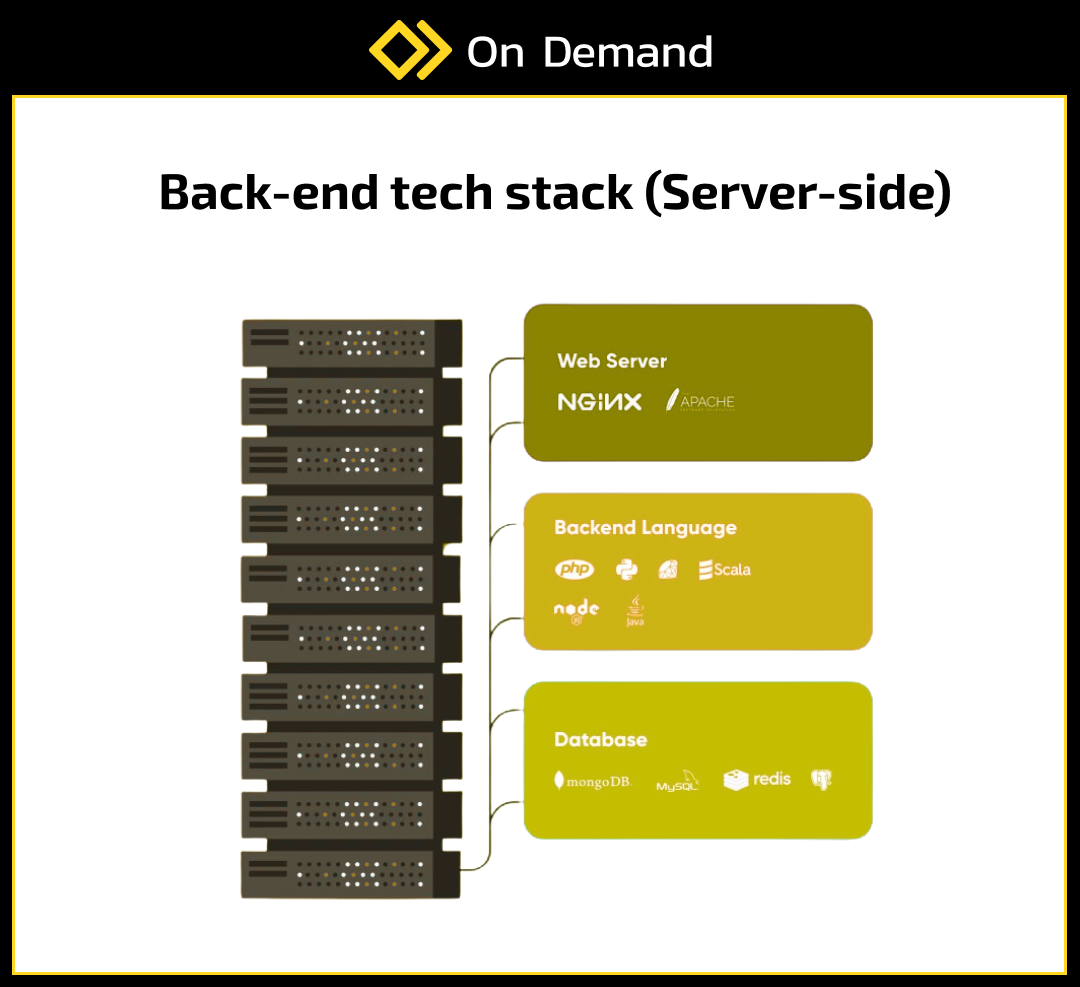
The back end is arguably the most important part behind the functioning of any mobile app. While the users can’t see it, it is this backend that powers the entire application and ensures its functionality. A proper on-demand app development technology stack ensures that this back-end architecture connects the content displayed on the front end with the CMS.
- Scripting Programming Languages
The technology stack for on-demand apps is powered by languages like Python and Ruby, which are usually favored for their easy learning curve. These also support proper on-demand app development technology stacks that favor server frameworks that make building back-end servers effortless. Node.JS is also gaining popularity due to its Express framework, enabling JS to smoothly add to the server.
- Back-End Servers
The back-end server, whether cloud-based or on-site, acts as the lifeblood of the on-demand mobile app network, providing shared resources like encryption, database, web services, file storage, and security. Cloud-based back-ends like AWS, Microsoft's Azure, and Google Compute Engine are popular for eliminating the need to set up the server, perform upgrades, and manage other tasks, with operations scaled as the business grows. This, in turn, helps on-demand app development technology stacks to run in a more optimized environment with required fail-safes already installed within the servers.
- Databases
The database is the dynamic part of the app's back-end that accepts user requests, fetches data, and responds 24/7. Different databases like NoSQL, MySql, and MongoDB are used depending on the app's requirements. This further fuels the functioning of the technology stack for on-demand apps.
- APIs
APIs (Application Programming Interface) are crucial for connecting the database, software, applications, and software. Various APIs like JSON API, REST API, GraphQL, and XML are used by on-demand app development companies to handle appointment requests, user data, payment processing, and notifications securely.
Effortless Functionality: Third-Party Integrations
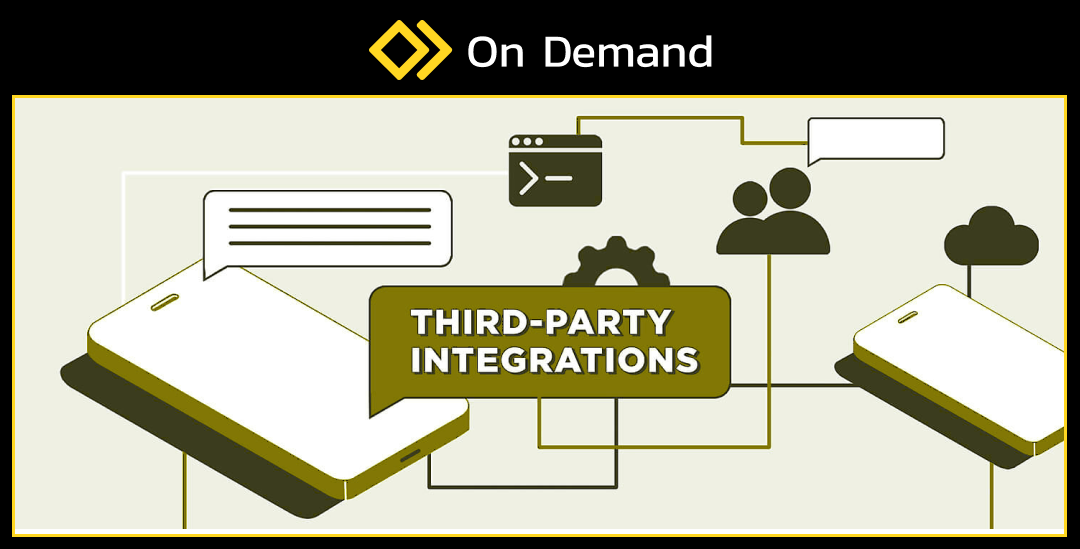
In custom on-demand app development technology stacks, developers leverage ready-to-integrate functionalities through third-party services like social channels, payment gateways, CRM, analytics tools, and maps to engineer apps efficiently.
- Social Media Integration
Social media platforms like Facebook, Instagram, Snapchat, and Twitter have APIs that are easy to integrate, enabling users to log in directly or share the app with a single click. This furthers the coherency of the software throughout the QA testing of any major on-demand app development company and fuels traffic toward the brand's digital storefronts.
- Payment Gateways
Payment gateway integration such as PayPal, Stripe, Authorize.net, and Braintree provides a seamless checkout experience, eliminating the need for businesses to manage transactions and security locally.
- Customer Resource Management (CRM)
CRM solutions like Zoho, Microsoft Dynamics, and SalesForce organize customer data for better understanding, outreach, service, and relationships. These CRM solutions serve an important role in the overall on-demand app development technology stack as they provide actionable feedback from the community and behavioral patterns for future optimization and efficiency of the software.
Conclusion
With the advent of technology and the popularization of on-demand solutions, the focus has shifted from shiny features to the underlying technology stack for differentiating apps. Understanding the technologies and tools that render the best experience to customers is vital. This blog has explained the technology used for front-end aesthetics and back-end functionality, along with third-party integrations. It is now your responsibility as a business owner or entrepreneur to choose the right on-demand app development technology stack that meets your business needs and goals and join hands with the right software partner to make your dream come to fruition.
FAQs
1. What is the technology stack for on-demand apps?
The technology stack for on-demand apps includes front-end technologies like HTML5, CSS3, JavaScript, and frameworks such as Angular and React. For the back end, languages like Python, Ruby, and Node.js are used, alongside databases like MySQL, and MongoDB, and cloud services like AWS and Azure. APIs and third-party integrations also play a crucial role in enhancing app functionality.
2. Why is the technology stack important for on-demand app development?
The technology stack is crucial because it determines the app's performance, scalability, and reliability. A well-chosen stack ensures seamless front-end interactions, efficient back-end processing, and robust third-party integrations. This ultimately enhances user experience and helps businesses meet their operational goals efficiently.
3. How do on-demand app development companies choose the right technology stack?
On-demand app development companies choose the technology stack based on several factors including the app's requirements, target platform (iOS, Android, or both), scalability needs, security concerns, and the specific functionalities desired. They also consider their team's expertise and the latest industry trends to ensure they are using the most effective and modern tools.
4. What are some common front-end technologies used in on-demand apps?
Common front-end technologies for on-demand apps include HTML5, CSS3, and JavaScript. Frameworks like Angular, React, and Bootstrap are also popular for creating responsive and interactive user interfaces. For Android, languages like Flutter, Java, and Kotlin are used, while Swift and Objective-C are used for iOS development.
5. Can you integrate third-party services into on-demand apps?
Yes, integrating third-party services is a common practice in on-demand app development. APIs for social media, payment gateways, CRM systems, and analytics tools are frequently used to enhance functionality. These integrations streamline processes, improve user experience, and provide valuable insights and capabilities essential for modern on-demand applications.







